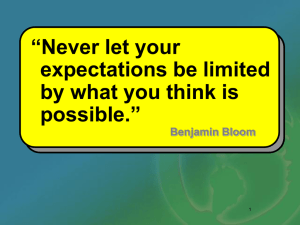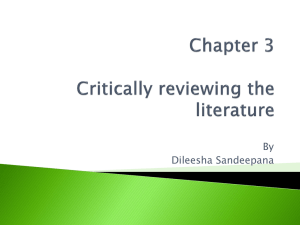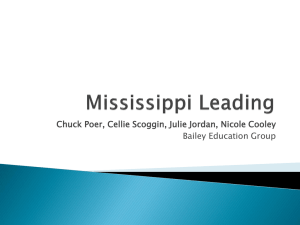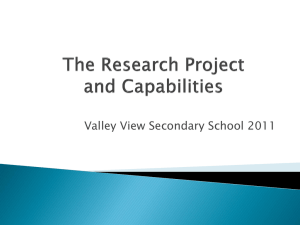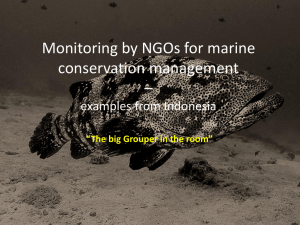Why Project Based Learning ? Overview
advertisement
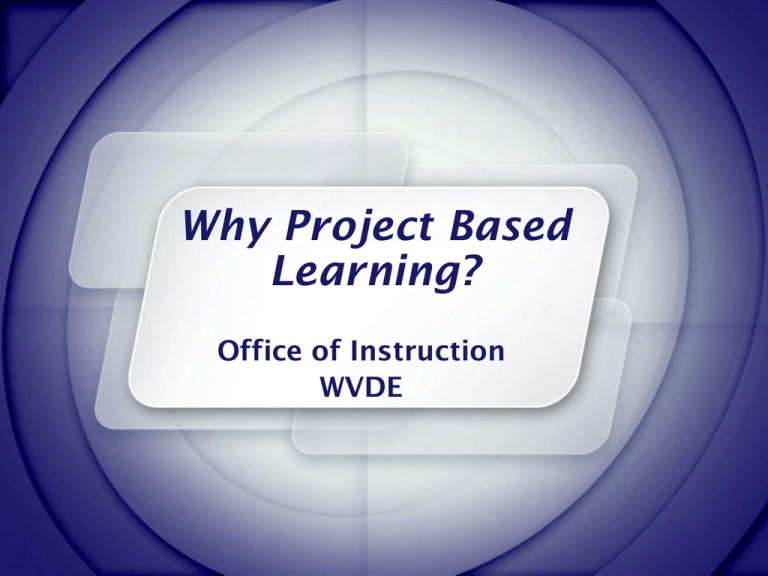
Why Project Based Learning? Office of Instruction WVDE Education exists in the larger context of society. When society changes – so too must education if it is to remain viable. Today’s Youth • • • • • Digital learners Multimedia Find and manipulate data Analyze data and images Care about relationships – MySpace – Facebook – Travel in groups Job Outlook 2002National Association of Colleges and Employers (NACE) The Rigor/Relevance Framework K N O W L E D G E T Evaluation 6 C A Synthesis 5 Assimilation X O Analysis 4 N Application 3 O M Understanding 2 A Y Awareness 1 Acquisition 1 Knowledge 2 Apply in discipline APPLICATION MODEL International Center for Leadership in Education D Adaptation B Application 3 Apply across disciplines 4 Apply to real world predictable situations 5 Apply to realworld unpredictable situations 6 Success Beyond the Test • • • • Core Academics Stretch learning Learner Engagement Personal Skill Development Relationships Rigor Relevance Learning Criteria • Core Academics – Achievement in the core subjects of English language arts, math, science, social studies and others identified by the school or district • Stretch Learning – Demonstration of rigorous and relevant learning beyond the minimum requirements Learning Criteria • Learner Engagement – The extent to which students are motivated and committed to learning; have a sense of belonging and accomplishment; and have relationships with adults, peers and parents that support learning • Personal Skill Development – Measures of personal, social, service, and leadership skills and demonstrations of positive behaviors and attitudes Learning Criteria Core Stretch Learner Engagement Personal Skill Development Learning Criteria Rigor/Relevance Framework Teacher/Student Roles C R I G O R D Student Think High A Low Student Think & Work B Teacher Work Low Relevance Student Work High The New Learning Formula 3 Rs X 7Cs = st 21 Century Learning 21st Century Skills • Critical Thinking & Problem Solving • Creativity & Innovation • Collaboration, Teamwork & Leadership • Cross-cultural Understanding • Communication & Media Literacy • Computing and ITC Technology • Career & Learning Self-direction st 21 Century Skills 7 C’s 1. Critical Thinking and Problem Solving 2. Creativity and Innovation 3. Collaboration, Teamwork and Leadership Component Skills 1. Research, Analysis, Synthesis, Project Management, etc. 2. New Knowledge Creation, Design Solutions, Storytelling 3. Cooperation, Compromise, Consensus, Community Building st 21 Century Skills 7 C’s Component Skills 4. Cross Cultural Understandings 4. Diverse ethnic, knowledge and organizational cultures 5. Communication and Media Literacy 5. Crafting and analyzing messages, using technology effectively 6. Computing and ITC Literacy 6. Effective use of electronic information and knowledge tools 21st Century Skills 7 C’s 7. Career and Learning Self Direction Component Skills 7. Managing change, lifelong learning, and career redefinition Creating a Learning Environment for 21st Century Skills Students working in teams to experience and explore relevant, real-world problems, questions, issues, and challenges; then creating presentations and products to share what they have learned. A Project Learning Classroom is ... • • • • • • • Project-centered Open-ended Real-world Student-centered Constructive Collaborative Creative • Communicationfocused • Research-based • Technologyenhanced • 21st Century reformfriendly • Hard, but fun! Today’s Students are Digital Natives Conventional Speed Step-by-Step Linear Processing Text First Work-Oriented Stand-alone Twitch Speed Random Access Parallel Processing Graphics First Play-Oriented Connected Digital Learners are Engaged by • Multitasking/Toggling • Multimedia learning • Online social networking • Online information searching • Games, simulations and creative expressions Project Learning is Skill-Based To learn collaboration – work in teams To learn critical thinking – take on complex problems To learn oral communication – present To learn written communications – write Project Learning is Skill-Based To learn technology – use technology To develop citizenship – take on civic and global issues To learn about careers – do internships To learn content – research and do all of the above Students Develop Needed Skills in Information Searching & Researching Critical Analysis Summarizing and Synthesizing Inquiry, Questioning and Exploratory Investigations Design and Problem-solving In a project learning classroom The teacher’s role is one of coach, facilitator, guide, advisor, mentor… not directing and managing all student work. Rigor/Relevance Framework Teacher/Student Roles C R I G O R D Student Think High A Low Student Think & Work B Teacher Work Low Relevance Student Work High Rigor/Relevance Framework Step 1. C R I G O R D High A Teacher gives students a realworld question to answer or problem to solve. B Low Low Relevance High Rigor/Relevance Framework R I G O R C D A Students seek B High Low information to answer question or solve problem. Low Relevance High Rigor/Relevance Framework C R I G O R D High A B Low Low Relevance Students test the relevancy of the information as it relates to the question or problem. High Rigor/Relevance Framework reflect C Students on the potential R I G O R High D use of the new information as a solution A B Low Low Relevance High Rigor/Relevance Framework C R I G O R D Students apply the information learned to answer the question or to solve the problem. High A B Low Low Relevance High Rigor/Relevance Framework C R I G O R High Rigor Critical Thinking A Low D Creativity – Innovation Problem Solving B Acquisition of knowledge/skills Low Relevance Motivation - Relevancy Validation High It is virtually impossible to make things relevant for, or expect personal excellence from, a student you don’t know. Carol Ann Tomlinson What Zone Am I In? Too Easy •I get it right away… •I already know how… •This is a cinch… •I’m sure to make an A.., •I’m coasting… •I feel relaxed,,, •I’m bored… •No big effort necessary. THIS is the place to be. On Target •I know some things… •I have to think… •I have to work… •I have to persist… •I hit some walls… •I’m on my toes… •I have to regroup… •I feel challenged… •Effort leads to success.. Too Hard •I don’t know where to start… •I can’t figure it out… •I’m spinning my wheels… •I’m missing key skills… •I feel frustrated… •I feel angry… •This makes no sense… •Effort doesn’t pay off… THIS is the achievement zone. Rigor/Relevance Framework Relationships C R I G O R High D Relationships Important A Low Relationships Essential B Relationships of little importance Low Relevance Relationships Important High 2008 Teacher Leadership Institute Backward Design Process • Begin with the End in Mind – – – – – – Develop a project idea Decide the scope of the project Select standards Incorporate simultaneous outcomes Work from project design criteria Create the optimal learning environment • Craft the Driving Question 2008 Teacher Leadership Institute Backward Design Process • Plan the assessment • Create a balanced assessment plan – Align products and outcomes – Know what to assess – Use rubrics 2008 Teacher Leadership Institute Backward Design Process • Map the Project – Organize tasks and activities – Decide how to launch the project – Gather resources – Draw a “Storyboard” • Manage the Process – Share project goals with students – Use problem-solving tools – Use checkpoints and milestones – Plan for evaluation and reflection
